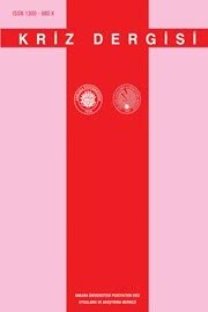ANKARA'DAKİ BEŞ EĞİTİM KURUMUNDA KENDİNİ YARALAMA DAVRANIŞI ÜZERİNE BİR ÇALIŞMA
Anahtar Kelimeler:
Kendini Yaralama Davranışı, Yaşam Doyumu, İntihar, Depresyon.
The studies tnat are executed on the selfinjurious behavior show that this behavior usually appear in the adolescence period and that those who self-injurious behavior are in the dense depression sense and that their committing suicide possibility is high. Even there is not sufficient information, it also is thought that the life satisfaction levels of those individuals can be low. Assessing the self-injurious behavior by the social psychiatric approach vvithin the interdiscipline team will increase the effectiveness of the prevention and treatment vvorks that are directed to this behavior, since its etiology has a complex and multi-factor structure. The aim of this research is to investigate life satisfactions, suicide possibilities and depression levels of individuals who behaved to injure themselves at five educational institutions in Ankara. At the result of this research vvhich has been seen that there are differences betvveen those who were in a self-injurious behavior and those who were not in a self-injurious behavior in their life satisfactions, possibility of suicide and depression levels.
Keywords:
Self-injurious Behavior, Life Satisfaction, Suicide, Depression.,
___
- Akdur R (1996). Sağlık Bilimlerinde Araştırma ve Tez Yapma Rehberi: Projelendirme, Uygulama, Rapor Yazma, Ankara.
- Bohus M, Lımberger M, Ebner U ve ark. (2000). Pain Perception During Self-reported Distress and Calmness in Patients with Borderline Personnality Disorder and Self-mutilating Behavior. Psychiatry Research, 95 (3): 251-260.
- Canat S (1999). Kendini Yaralama Davranışı (Self-Mutilasyon). Klinik Psikiyatri, 1: 46-48.
- Deiter JP, Nıcholls SS, Pearlman AL (2000). Self-injury and Şelf Capacities: Assisting an Individual in Crisis. Journal of Clinical Psychology, 56 (9): 1173-1191.
- Groholt B, Ekeberg O, Wichstrom L ve ark. (2000). Young Suicide Attempters: A Comparison Betvveen a Clinical and an Epidemiological Sample. J Am Acad Child Adolesc Psychiatry, 39 (7): 868-875.
- Haw C, Houston K, Tovvnsend E ve ark. (2001). Deliberate Self-harm Patients with Alcohol Disorders: Characteristics, Treatment and Outcome. Crisis, 22 (3): 93-101.
- Havvton K, Fagg J, Simkin S ve ark. (2000). Deliberate Self-harm in Adolescents in Oxford 1985- 1995. Journal of Adolescence, 23 (1): 47-55.
- Hawton K, Kingsbury S, Steinhardt K ve ark. (1999). Repetition of Deliberate Self-harm by Adolescents: The Role of Psychologicalfactors. Journal of Adolescence, 22 (3): 369-378.
- Kaplan IH, Sadock JB (1996). I. Basamak Psikiyatri El Kitabı. İng. Çev. Banu Büyükdal (1998), İstanbul, Turgut Yayıncılık, s. 231-237.
- Köker S (1991 . Normal ve Sorunlu Ergenlerin Yaşam Doyumu Dü, eyinin Karşılaştırılması. Ankara Üniversitesi Sosya Bilimler Enstitüsü Eğitimde Psikolojik Hizmetler îölümü Yüksek Lisans Tezi.
- Köknel Ö (198'i). Depresyon: Ruhsal Çöküntü. İstanbul, Altın Kitapi. ir Yayınevi.
- Nijman HLI, Da ıtzenberg M ve ark. (1999). Selfmutilating Behaviou' of Psychiatric Inpatients. Eur Psychiatry, 14: 4-10.
- Savaşır I, Şahin HN (1997). Bilişsel-Davranışçı Terapilerde Değerlendirme: Sık Kullanılan Ölçekler. Ankara, Türk Psikolo jlar Derneği Yayınları.
- Suyemoto LK 1998). The Functions of Selfmutilation. Cliniccal l'sychology Revievv, 18 (5): 531- 554.
- Sümbüloğlu V, Sümbüloğlu K (1998). Sağlık Bilimlerinde Araştırına Yöntemleri. İkinci Basım, Ankara, Hatipoğlu Ye yınevi.
- Symons FJ, K ıppekin A, VVehby JH (1999). Treatment of Self-inj jrious Behavior and Quality of Life for Persons w th Mental Retardation. Ment Retard, 37 (4): 297-3 )7.
- Tezcan S ( 992). Epidemiyoloji: Tıbbi Araştırmaların Yöntem Bilimi. Ankara, Hacettepe Halk Sağlığı Vakfı Yayını.
- Tuğcu H (1996 . Normal ve Depresif Kişilerde Çeşitli Faktörlere Güre İntihar Olasılığı. Ankara, Hacettepe Üniversit ?si Sosyal Bilimler Enstitüsü Psikolojik Danışma v a Rehberlik Bilim Dalı Doktora Tezi.
- Wood A, Traınc G, Rothvvell J ve ark. (2001). Randomized Trial of Group Therapy for Repeated Delibarate Self-harm in Adolescents. J Am Acad Child Adolesc Psychi ıtry, 40 (11): 1246-1253.
- ISSN: 1300-980X
- Başlangıç: 1992
- Yayıncı: Ankara Üniversitesi
